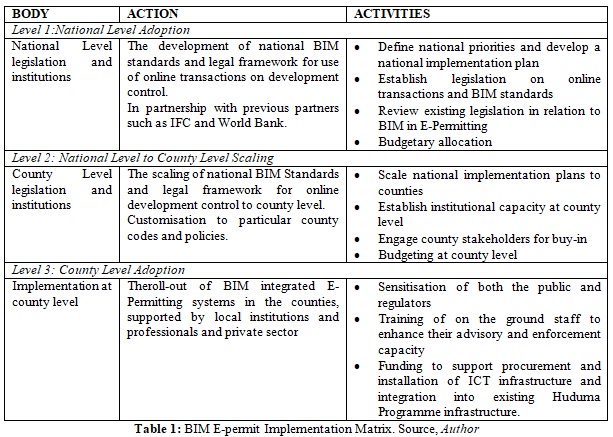Building Information Modelling in Urbanising Kenya
DOI:
https://doi.org/10.31033/ijemr.13.1.18Keywords:
Building Information Modelling (BIM), Development Control, E-permitting, TechnologyAbstract
With the largest economy is East and Central Africa, Kenya serves as a regional centre for banking, technology and infrastructure. In the last ten years Kenya has experienced strong growth and development, largely anchored in the Country’s Vision 2030. Vision 2030 is a long term view of Kenya’s development intended to transform Kenya into a middle income country with a high quality of life by 2030. The vision is anchored on 3 pillars; economic, social and political. For ease of implementation the vision is entrenched in the 2010 constitution and has been divided into 5-year mid-term plans (MTP’s) coinciding with the electoral calendar. The current MTP was adopted in 2013 and includes a strong focus on digital transformation. This because, technology is increasingly playing a valuable role in communities, but also a highly disruptive role.
Our communities are changing as a result of technology. Increased technological possibilities are resulting in faster and cheaper production of goods and services; the advent of technology has seen a shift in the needs of our communities, from requiring basic provision of infrastructure to needing more advanced technology appropriate infrastructure; technology has changed how information is communicated and received in our communities, and finally technology and its rapid speed of change has meant that we now question the viability of our existing buildings and infrastructure, and a step further, the viability even of the plans we have for future development.
However, it is not all doom and gloom. It is possible through specific and deliberate strategies to harness the benefits of technology. To do this, communities and built industry professionals need to have a clear strategy that identifies where the biggest difference can be made with technology, and then align infrastructure and building provision goals and technology requirements with choices that are guided by a community-centred approach. To think, how will implementing this technology affect the community in which it is implemented?
Since 2011, The World Bank, through the Kenya Investment Climate Program in partnership with the Architectural Association of Kenya and four County Governments of Nairobi, Mombasa, Kisumu and Kiambu have developed and are now successfully running automation of all approval and administrative processes associated with Construction Permits. This integration of technology to construction permitting has had numerous benefits: reduced time and costs for regulators and investors, has encouraged best practice among professionals and raised the level of safety in construction projects.
In advocating for the integration of BIM to construction e-permit systems in urbanising Kenya, this paper demonstrates how technology can be harnessed to steer urbanisation while working for the good of the community. The ubiquity of technology is transforming how professional services are procured and offered. Full service models are being replaced by a new service framework, with either self or automated services, or, custom services becoming predominant. This necessitates a re-thinking of how we engage our communities in our quest to offer professional services against the backdrop of urbanisation.
The novelty of BIM use is the possibility to integrate various aspects of infrastructure and building provision from site surveys through to community feedback and local authority approval on one platform. This paper will explore best practice in BIM use around the world as a catalyst for harnessing technology to address the challenge of rapid change in urbanising communities. In advocating for BIM institutionalisation and integration with the existing e-permitting systems in Kenya, this paper will suggest ways in which these best practices can appropriately be applied to the unique community that is rapidly urbanising Kenya.
Downloads

Downloads
Published
How to Cite
Issue
Section
License
Copyright (c) 2023 Peter Njeru NJUE, Marylyn MUSYIMI

This work is licensed under a Creative Commons Attribution 4.0 International License.











